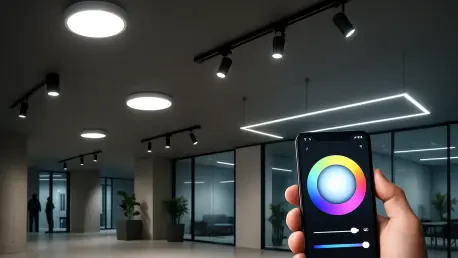Imagine walking into a commercial building where the lights automatically adjust to the time of day, dimming during low-traffic hours to save energy, brightening to highlight a retail display, or even alerting security to unusual activity. This isn’t a distant dream but a reality made possible by smart lighting technology. As commercial spaces evolve to meet modern demands for efficiency, safety, and design, smart lighting emerges as a pivotal solution. This roundup gathers insights, opinions, and tips from various industry perspectives to explore how intelligent lighting systems are reshaping commercial environments, offering a comprehensive look at their transformative potential.
Illuminating the Future of Commercial Design with Smart Lighting
The journey of lighting in commercial spaces has seen a remarkable shift from basic incandescent bulbs to sophisticated, intelligent systems. Traditional fixtures once served the sole purpose of illumination, but today’s smart lighting integrates seamlessly with building management platforms, enabling functionalities like remote control and real-time monitoring. Industry observers note that this evolution reflects a broader trend toward automation and connectivity in facility management.
Beyond just lighting up a room, smart systems now play a critical role in optimizing operations. They sync with other technologies to provide data on occupancy patterns or energy usage, fundamentally changing how spaces are managed. This integration creates opportunities for businesses to rethink their environments, making them more responsive to both human and operational needs.
The potential of smart lighting extends into multiple dimensions, from slashing energy costs to bolstering security measures and enhancing visual appeal. These benefits are not merely incremental but represent a paradigm shift in commercial design. As this discussion unfolds, the focus will turn to specific impacts and practical applications, drawing from a range of expert views and real-world examples.
Unpacking the Impact of Smart Lighting on Commercial Settings
Revolutionizing Energy Efficiency with Intelligent Systems
One of the most celebrated advantages of smart lighting is its ability to reduce energy consumption dramatically. Features like automated dimming, occupancy sensors, and scheduling allow lights to operate only when needed, cutting down on waste. Industry reports suggest that such systems can lower energy use by up to 30% in commercial buildings, a significant saving for large-scale operations.
Products like Kyocera’s G7A Series exemplify this trend with air-cooled technology that maximizes efficiency without requiring resource-heavy cooling methods. These innovations are often highlighted by facility management professionals as game-changers, especially for industrial and office settings where lighting accounts for a substantial portion of energy bills. The consensus among energy consultants is that such advancements justify the investment over time.
However, challenges persist in adopting these systems, particularly the upfront costs and compatibility with older building infrastructure. Some facility managers caution that retrofitting can be complex and may require significant planning. Balancing these hurdles with long-term savings remains a key discussion point, with many advocating for phased implementations to mitigate financial strain.
Enhancing Security and Functionality Through Integrated Tech
Smart lighting’s integration with security technologies offers another layer of transformation for commercial spaces. Solutions like Wyze’s Bulb Cam, which combines illumination with motion detection and AI-driven alerts, are frequently cited by security experts as vital tools for modern facilities. These dual-purpose products provide both visibility and surveillance, enhancing safety without additional hardware.
Real-world applications demonstrate this impact clearly, especially in outdoor areas such as parking lots or building perimeters. Facility managers often share examples of how such systems deter unauthorized access while ensuring well-lit environments for employees and visitors. The ability to monitor spaces in real time through smartphone connectivity is also praised as a significant operational advantage.
Yet, concerns about data privacy and cybersecurity are raised by tech analysts, given the connected nature of these devices. The risk of breaches in commercial installations necessitates robust protective measures, a point often emphasized in discussions about scaling smart systems. Addressing these vulnerabilities is seen as essential to maintaining trust and functionality in integrated setups.
Shaping Aesthetics and Ambiance with Customizable Illumination
The design flexibility offered by smart lighting is transforming how commercial spaces are perceived, with tunable colors and dynamic settings creating tailored atmospheres. Innovations like Bridgelux’s DriveLux DX4 Series, which allow for adjustable white light and vibrant hues, are frequently mentioned by interior designers as tools to craft unique experiences. Retail and hospitality sectors, in particular, benefit from these customizable options to attract and engage customers.
Different industries leverage these trends in varied ways, with regional preferences also playing a role in design choices. For instance, warmer tones might dominate hospitality spaces in certain areas to evoke comfort, while cooler, brighter lights are preferred in offices for productivity. Architects and lighting consultants often debate the balance between functionality and flair, but most agree that aesthetics significantly influence user perception.
Challenging the traditional view, many in the design community argue that lighting transcends mere utility to become a core element of brand identity. In commercial environments, the right ambiance can differentiate a business, impacting customer loyalty and employee satisfaction. This perspective underscores the strategic importance of investing in adaptable lighting solutions.
Driving Operational Control with Seamless Automation
The ability to manage lighting remotely through platforms like Alexa or Google Assistant is a standout feature for operational efficiency, as noted by technology integrators. Smart systems allow facility managers to adjust settings from anywhere, streamlining tasks that once required on-site presence. This automation is often described as a time-saver, especially in sprawling commercial complexes.
Case studies, such as the use of Acclaim Lighting’s Linear XTR # in large-scale setups, illustrate the scalability of these solutions, with experts predicting future advancements like AI-driven predictive adjustments. Such innovations could anticipate lighting needs based on historical data, further optimizing performance. Tech enthusiasts frequently highlight the potential for these systems to evolve with emerging technologies.
Beyond saving time, automation opens doors to data-driven decision-making, a point often raised by facility management advisors. Insights gathered from smart lighting can inform broader operational strategies, from space utilization to maintenance schedules. This analytical capability is seen as a stepping stone to smarter, more responsive commercial environments.
Key Insights and Practical Steps for Adopting Smart Lighting
Synthesizing opinions from energy experts, security specialists, and design professionals, several core benefits of smart lighting stand out as transformative for commercial spaces. Energy savings, improved security through integrated tech, design versatility for better ambiance, and operational efficiency via automation are consistently identified as major advantages. These elements collectively redefine how facilities function and are experienced.
For businesses considering adoption, practical advice centers on starting small with pilot projects in high-traffic zones to test effectiveness and gather feedback. Many consultants recommend prioritizing systems with scalable features to accommodate future growth or technological updates. This phased approach helps manage costs while building confidence in the technology.
Facility managers are also encouraged to assess compatibility with existing infrastructure before full implementation. Partnering with vendors for tailored solutions is another tip frequently shared by industry veterans, ensuring that specific needs and challenges are addressed. These steps, grounded in real-world experience, aim to smooth the transition to intelligent lighting systems.
Looking Ahead: The Bright Potential of Smart Lighting
Reflecting on the insights gathered, it is evident that smart lighting has fundamentally altered the landscape of commercial spaces by merging technology with sustainability and style. The discussions highlighted a shared belief among industry voices that these systems are integral to creating smarter, greener buildings. The enthusiasm for their role in enhancing both functionality and aesthetics was palpable across various perspectives.
As a next step, businesses are advised to explore partnerships with technology providers to stay ahead of emerging trends in lighting integration. Considering the rapid pace of innovation, keeping an eye on advancements like AI-driven systems or enhanced energy solutions is seen as crucial. These considerations point toward a future where smart lighting will continue to evolve, offering even greater value to commercial environments.









